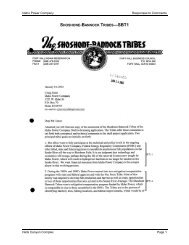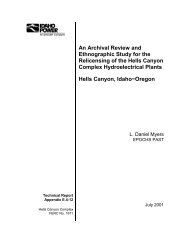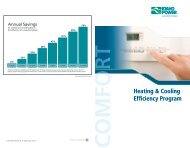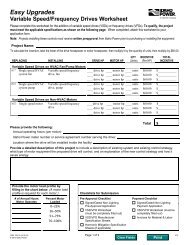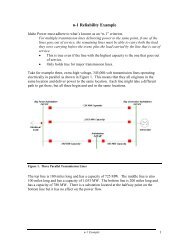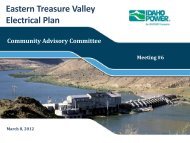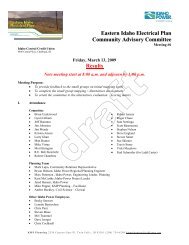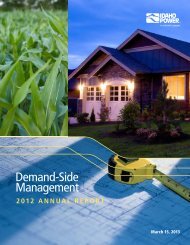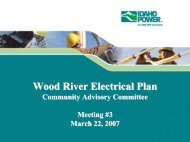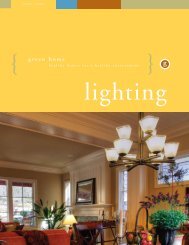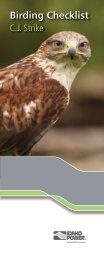Assessment of Chukar and Gray Partridge Populations - Idaho Power
Assessment of Chukar and Gray Partridge Populations - Idaho Power
Assessment of Chukar and Gray Partridge Populations - Idaho Power
- No tags were found...
Create successful ePaper yourself
Turn your PDF publications into a flip-book with our unique Google optimized e-Paper software.
Hells Canyon <strong>Chukar</strong> <strong>and</strong> <strong>Gray</strong> <strong>Partridge</strong> Report, Ratti <strong>and</strong> Giudice 405.1.2. Fall-Winter SurveysThe study area contained approximately 104 river miles (i.e., river miles 247 to 351).We attempted to survey every 4 th river-mile segment from the water line to approximately 0.5miles laterally from the river, <strong>and</strong> approximately perpendicular from the general river-flowdirection. Surveys generally followed a circular pattern from the water edge to the nearestadjacent rim, <strong>and</strong> back to the starting point (but deviations from this pattern were common due toterrain that could not be safely traversed. Surveys were conducted on the Oregon <strong>and</strong> <strong>Idaho</strong>sides <strong>of</strong> the river. We conducted fall-winter surveys in 1999 <strong>and</strong> 2000. Surveys were distributedthroughout the study area between Weiser <strong>and</strong> Hells Canyon Dam. A general organization <strong>of</strong>survey segments is provided in Table 1. We were prohibited from surveying some riversegments due to access limitations (e.g., no trespassing designations, steep cliff walls <strong>and</strong> talusslopes too dangerous for foot access). In such cases we attempted use <strong>of</strong> the following selectionprocess (in order <strong>of</strong> priority) to choose alternate sites: 1) change survey site to opposite side <strong>of</strong>river, 2) to ½ or 1 mile upstream, same side, 3) to ½ or 1 mile upstream, opposite side, 4) to ½ or1 mile down stream, same side, or 5) to ½ or 1 mile down stream, opposite side.Each survey consisted <strong>of</strong> 2 people walking from waterline toward the canyon rim, <strong>and</strong>me<strong>and</strong>ering among habitats. All surveys were conducted during open hunting season forpartridge in <strong>Idaho</strong> <strong>and</strong> Oregon. We used trained bird dogs (setters <strong>and</strong> retrievers) to assist withlocating birds. Each survey consisted <strong>of</strong> 4-6 hours <strong>of</strong> walking (but did not exceed 6 hr). Allbirds observed were recorded by species <strong>and</strong> estimated flock size. However, as noted above,these data were intended only to assist with a qualitative assessment <strong>of</strong> populations <strong>and</strong> were notintended for statistical analysis or quantitative conclusions regarding populations.During each survey we classified habitat conditions as 1) excellent, 2) good, 3) fair, or 4)poor. Habitat classifications were based on a qualitative assessment <strong>of</strong> a combination <strong>of</strong> 1)habitat structure (e.g., woody vegetation vs. grass <strong>and</strong> forbs, rock outcroppings, talus slopes, cropl<strong>and</strong>), 2) presence <strong>of</strong> food-plants (e.g., grasses, forbs), <strong>and</strong> 3) overall habitat quality (e.g., density<strong>and</strong> height <strong>of</strong> cover, grazing impacts, etc.). Classifications were based on an ocular estimate <strong>of</strong>overall habitat conditions within the boundaries <strong>of</strong> our circular survey pattern. Overall habitatassessment considered needs for escape cover (e.g., from predators <strong>and</strong> severe weather), nesting



